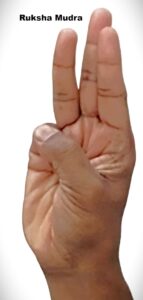Ruksha Mudra
Introduction
Mudras are yogic hand gestures that influence the flow of prana (life energy), helping to harmonize body, mind, and subtle energies. Ruksha Mudra is known as the “Drying or Detoxifying Mudra”, traditionally used to reduce excess fluids, control moisture in the body, and balance Kapha dosha.
The name “Ruksha” in Sanskrit means “dry” or “arid,” indicating its primary function of absorbing excess moisture and promoting metabolic and energetic balance. This mudra is often used in detoxification practices, weight management, and Kapha-pacifying routines.
Meaning
Ruksha = Dry, arid, or desiccated.
Mudra = Yogic seal or gesture.
Purpose: To control excess moisture, support detoxification, reduce Kapha imbalance, and enhance overall energy flow.
How to Perform (Practice)
Sit comfortably in a meditation posture such as Sukhasana, Padmasana, or Vajrasana.
Relax shoulders, spine, and arms.
Try to touch the base of your thumb with the tip of your small finger as shown in the image.
Slightly press your thumb on the bent small finger.
Keep all the other fingers straight as shown in the image.
Close your eyes and focus on energy flowing to balance excess moisture and Kapha in the body.
Maintain the mudra for 5–15 minutes, gradually increasing as comfort improves.
Tip: Keep fingers gently touching and avoid tension in the hands or arms.
Benefits
Physical Benefits
Reduces excess Kapha dosha, which can manifest as fluid retention or lethargy.
Supports detoxification and metabolism.
Helps alleviate obesity-related issues.
Enhances circulation and energy flow in the body.
Mental & Emotional Benefits
Reduces mental lethargy and drowsiness associated with high Kapha.
Improves focus, clarity, and mental alertness.
Promotes emotional stability and calmness.
Spiritual Benefits
Directs subtle energy toward purification and balance.
Supports meditation by clearing stagnant energy and promoting focus.
Harmonizes prana flow, contributing to overall energetic equilibrium.
Contraindications
Finger, hand, or wrist injuries.
Individuals with excess dryness (Vata imbalance) should practice moderately.
Avoid over-practice if hands, arms, or shoulders feel strained.
Anatomy & Physiology
Musculoskeletal: Activates intrinsic hand muscles and stabilizes fingers.
Circulatory system: Improves blood flow to hands and upper limbs.
Digestive system: Supports metabolism and fluid regulation indirectly.
Nervous system: Stimulates sensory nerves, promoting alertness and parasympathetic balance.
Endocrine system: Supports energy balance and detoxification processes.
Kinesiology
Thumb, middle, and little fingers form a triangular seal, guiding energy flow.
Index and ring fingers extended, lightly engaging hand muscles.
Neutral wrist alignment avoids strain.
Enhances proprioception, hand stability, and subtle energy direction.
Neurology
Stimulates sensory nerve endings in fingers, enhancing mind-body integration.
Activates parasympathetic and sympathetic balance, supporting detoxification and alertness.
Improves cortical awareness associated with focus, energy balance, and emotional regulation.
Enhances subtle energy flow related to Kapha and moisture balance.
Duration of Mudra
Beginners: 5 minutes.
Intermediate: 10–15 minutes.
Advanced: 20–30 minutes during meditation or pranayama.
Tip: Regular practice balances Kapha, moisture, and mental clarity.
Counter Mudra
Apana Mudra: To release stagnant fluids and toxins.
Prana Mudra: To energize the body after Kapha-reducing practice.
Gyan Mudra: To combine focus with energetic balance.
Conclusion
Ruksha Mudra is a Kapha-pacifying mudra that reduces excess moisture, enhances metabolism, and promotes physical and mental alertness. Regular practice integrates physical, emotional, and subtle energy benefits, making it ideal for detoxification, meditation, and yogic wellness.
FAQ
Q1. Can beginners practice this mudra?
Yes, it is safe for all levels with gentle practice.
Q2. Can it help with fluid retention or lethargy?
Yes, it is particularly beneficial for Kapha imbalance symptoms.
Q3. How long should it be practiced daily?
5–15 minutes for beginners; up to 30 minutes for advanced practitioners.
Q4. Can it be combined with pranayama?
Yes, especially with Kapalabhati or Anulom Vilom for detoxification and energy balance.
References
Swami Satyananda Saraswati, Asana, Pranayama, Mudra, Bandha.
B.K.S. Iyengar, Light on Yoga.
Hatha Yoga Pradipika – Mudras for Kapha and energy balance.
Gheranda Samhita – Mudras for detoxification and metabolic balance.
Kuvalayananda, Yoga Mimamsa Journal.

